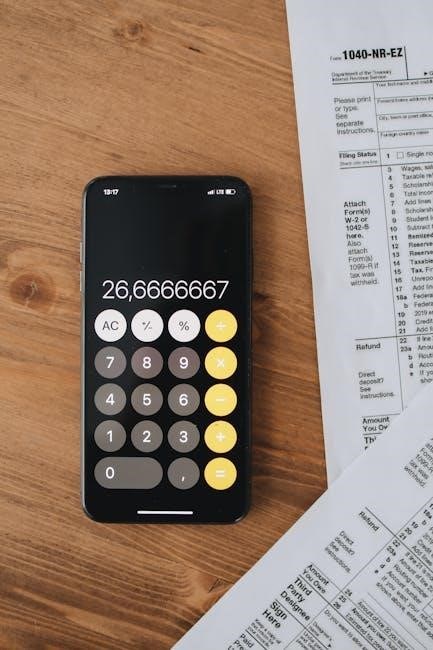Decimal multiplication worksheets are essential tools for mastering decimal operations. They provide structured practice, covering various skills like multiplying decimals by whole numbers or decimals, with real-world applications.
What are Decimal Multiplication Worksheets?
Decimal multiplication worksheets are educational resources designed to help students practice and master the skill of multiplying decimal numbers. These worksheets typically include a variety of problems, such as multiplying decimals by whole numbers or other decimals, and often feature real-world applications. They are available in PDF format, making them easy to download, print, and use in classrooms or at home. Many worksheets cater to specific grade levels, like 5th or 6th grade, and offer a mix of easy, medium, and complex questions to suit different learning needs. They are a convenient and effective tool for reinforcing decimal multiplication concepts.
Why are Decimal Multiplication Worksheets Important?
Decimal multiplication worksheets are crucial for building a strong foundation in mathematical operations involving decimals; They provide structured practice, helping students understand how to multiply decimals by whole numbers or other decimals accurately. These worksheets also introduce real-world applications, making math relatable and practical. Regular use of these resources improves problem-solving skills, enhances mental math abilities, and boosts confidence in handling monetary and measurement calculations. Additionally, they serve as diagnostic tools for teachers to identify areas where students may need extra support. Overall, they are indispensable for developing fluency and precision in decimal multiplication, a skill essential for everyday life and advanced studies.
How to Use Decimal Multiplication Worksheets Effectively
To use decimal multiplication worksheets effectively, start by setting clear learning objectives. Begin with simpler problems, gradually increasing difficulty. Encourage students to rewrite problems vertically for better alignment. Use visual aids like place value charts to reinforce concepts. Provide step-by-step examples and guide students through the multiplication process. Encourage peer discussion to enhance understanding. Regular practice and timely feedback are crucial for improvement. Incorporate real-world scenarios to make learning relevant. Track progress to identify areas needing extra support. Utilize interactive online tools for engagement. By following these strategies, students can master decimal multiplication efficiently and confidently.

Types of Decimal Multiplication Worksheets
Decimal multiplication worksheets come in various forms, including printable PDFs, interactive online versions, and specialized sheets for different skill levels. They cater to diverse learning needs and preferences.
Printable PDF Worksheets
Printable PDF worksheets are a convenient and popular choice for practicing decimal multiplication. Designed for easy printing, they offer a structured approach to learning, covering various skill levels and question types. Many PDFs include a mix of easy, medium, and complex problems, ensuring a comprehensive understanding. They are ideal for classroom use, home study, or tutoring sessions, providing students with ample practice to master decimal multiplication. Their portability and accessibility make them a valuable resource for educators and learners alike. They ensure consistency in practice, helping students build confidence and accuracy in decimal operations, essential for real-world applications.

Interactive Online Worksheets
Interactive online worksheets offer a dynamic and engaging way to practice decimal multiplication. They often feature clickable buttons, drag-and-drop activities, and instant feedback, making learning more immersive. These digital tools provide real-time scoring and progress tracking, helping students identify strengths and areas for improvement. Many platforms allow customization, enabling teachers to tailor exercises to specific skill levels or focus on particular problem types. Interactive worksheets are accessible on various devices, promoting flexible learning. They cater to diverse learning styles, incorporating animations and hands-on activities to enhance understanding. This modern approach fosters active participation and makes practicing decimal multiplication enjoyable and effective for students of all ages.
Specialized Worksheets for Different Skill Levels
Specialized decimal multiplication worksheets cater to diverse skill levels, ensuring tailored practice for each learner. Beginners can start with simple problems, such as multiplying decimals by whole numbers, while advanced students tackle complex operations like decimal-to-decimal multiplication. These worksheets are designed to gradually build proficiency, with clear instructions and examples. They often include mixed-level exercises to reinforce concepts and challenge students appropriately. By offering varied difficulty levels, these resources help educators meet the needs of all learners, providing a comprehensive approach to mastering decimal multiplication.
Worksheets Focused on Real-World Applications
Worksheets focused on real-world applications bridge academic concepts with practical scenarios, making learning relevant and engaging. These resources often include problems involving money, measurements, and scaling recipes, helping students see the importance of decimal multiplication in everyday life. For instance, calculating total costs, determining quantities for recipes, or measuring materials for projects are common themes. By connecting math to real-life situations, these worksheets enhance understanding and retention, preparing students to apply their skills confidently in various contexts beyond the classroom.

How to Create Effective Decimal Multiplication Worksheets
Designing effective worksheets involves mixing problem types, aligning with curriculum goals, and using clear instructions. Ensure problems are relevant, challenging, and provide space for calculations.
Step-by-Step Guide to Designing Worksheets
Start by defining the target skill level and learning objectives. Organize problems from simple to complex, ensuring clarity and progression. Incorporate visual aids like place value charts for better understanding. Include a mix of decimal multiplication scenarios, such as by whole numbers or other decimals, and provide word problems for real-world application. Add answer keys for easy grading. Use clear formatting with ample space for calculations to prevent clutter. Finally, review the worksheet for accuracy and relevance to ensure it meets educational standards and engages learners effectively.
Incorporating Visual Aids and Examples
Visual aids like place value charts, number lines, and decimal grids enhance understanding. Include step-by-step examples to demonstrate concepts, such as aligning decimals and placing the decimal point correctly. Use real-world scenarios, like calculating total costs or measurements, to make problems relatable. Add diagrams or illustrations to simplify complex multiplication steps. Provide solved problems with highlighted steps to guide learners. Incorporate blank grids for students to practice aligning decimals independently. These visual tools help students grasp multiplication patterns and build confidence in their calculations, making worksheets more engaging and effective for learning.
Aligning Worksheets with Curriculum Standards
Decimal multiplication worksheets should align with curriculum standards to ensure comprehensive learning. They are designed to cover essential skills, such as multiplying decimals by whole numbers or other decimals, and cater to specific grade levels. Worksheets for Grade 5 focus on foundational concepts, while Grade 6 sheets introduce more complex problems. By adhering to curriculum standards, these resources ensure students master required skills progressively. They often include a mix of straightforward and challenging problems, reinforcing concepts like place value and real-world applications. This alignment helps educators ensure students are well-prepared for advanced math topics and meet educational benchmarks effectively.

Skills Developed Through Decimal Multiplication Worksheets
These worksheets enhance understanding of decimal place value, improve accuracy in multiplying decimals by whole numbers or decimals, and strengthen mental math and problem-solving abilities.
Understanding Decimal Place Value
Mastering decimal place value is foundational for multiplying decimals. Worksheets help students recognize tenths, hundredths, and thousandths, ensuring accurate alignment of decimal points during calculations. By practicing with various problems, learners grasp how each digit’s position affects the overall value, reducing errors in multiplication. These exercises build a strong numerical understanding, essential for more complex operations. Regular practice with decimal place value worksheets enhances precision and confidence in handling decimal numbers, making multiplication more intuitive and efficient.
Multiplying Decimals by Whole Numbers
Multiplying decimals by whole numbers is a fundamental skill enhanced through practice worksheets. These exercises teach students to align decimal points correctly and apply multiplication strategies. Worksheets often include problems like 0.5 × 8 or 3.7 × 6, helping learners understand how decimals interact with whole numbers. By solving these, students build confidence and accuracy, essential for real-world applications. PDF worksheets provide structured practice, ensuring mastery of this key math concept and preparing students for more complex decimal operations. Regular use of these resources fosters a solid foundation in decimal multiplication.
Multiplying Decimals by Decimals
Multiplying decimals by decimals is a challenging yet crucial math skill. Worksheets offer targeted practice, guiding students through problems like 0.4 × 0.5 or 2.3 × 1.7. These exercises emphasize correct decimal placement and precise calculation. PDF resources often include step-by-step examples, helping learners grasp the concept. By practicing regularly, students develop the ability to handle complex decimal multiplication, essential for advanced math topics. These worksheets ensure a smooth transition to higher-level problems, reinforcing understanding and building confidence in decimal operations.
Improving Mental Math Skills
Decimal multiplication worksheets are invaluable for enhancing mental math abilities. By practicing problems like 0.5 × 1.2 or 3.7 × 0.4, students develop quick calculation skills. Regular exposure to these exercises trains the mind to recognize patterns and understand decimal place value intuitively. Over time, learners can perform complex multiplications without paper, boosting confidence and math fluency. These sheets also include real-world scenarios, making mental math relevant and practical. Interactive games and challenges further engage students, fostering a deeper understanding and mastery of decimal multiplication concepts in a fun and dynamic way.
Common Mistakes in Decimal Multiplication
Common errors include misplacing decimal points, incorrect counting of decimal places, and forgetting adjustments for multiples of 10. These mistakes can lead to significant inaccuracies in results.
Misplacing the Decimal Point
Misplacing the decimal point is a frequent error in decimal multiplication. It often occurs due to rushing or lack of attention, leading to incorrect placement during calculations. For instance, a student might incorrectly place the decimal, resulting in a product that is either tenfold or one-tenth of the correct value. This mistake can significantly affect the accuracy of financial calculations or scientific measurements; Worksheets designed to highlight decimal placement can help students recognize and correct this error. Regular practice with such exercises ensures better understanding and minimizes the occurrence of this common pitfall in decimal multiplication tasks.
Incorrect Counting of Decimal Places
Incorrect counting of decimal places is another common mistake in decimal multiplication. Students often miscount the total number of decimal places in the factors, leading to misplaced decimals in the product. For example, multiplying 2.5 (one decimal place) by 3.2 (one decimal place) should result in 8.0 (one decimal place combined). Worksheets designed to focus on decimal place counting can help students recognize this pattern and avoid errors. Targeted exercises ensure learners develop a strong understanding of place value, reducing mistakes and building confidence in decimal multiplication tasks.
Forgetting to Adjust for Multiples of 10
Forgetting to adjust for multiples of 10 is a frequent error in decimal multiplication. When multiplying by 10, 100, or 1,000, students often neglect to move the decimal point, leading to incorrect results. For instance, multiplying 5.3 by 10 should shift the decimal one place, resulting in 53, not 5.3. Worksheets with targeted exercises on multiplying by powers of 10 can help students recognize and correct this mistake. Including problems like 2.7 x 100 or 0.9 x 10 ensures learners understand the pattern and apply it consistently, reducing errors and improving their mastery of decimal operations.

Best Practices for Teaching Decimal Multiplication
Effective strategies include using real-world examples, introducing concepts gradually, and encouraging peer discussion. These methods build confidence and ensure a solid understanding of decimal operations.
Using Real-World Examples
Integrating real-world examples into decimal multiplication practice enhances learning. Worksheets often feature scenarios like shopping, cooking, or measuring, making concepts relatable. For instance, calculating total costs or adjusting recipe ingredients demonstrates practical applications. Such examples help students visualize how decimal multiplication applies to daily life, improving engagement and retention. Aligning these examples with curriculum standards ensures comprehensive understanding. By connecting abstract math to tangible situations, students develop problem-solving skills and confidence in handling real-world challenges. This approach fosters a deeper appreciation for the relevance of decimal multiplication in everyday activities, making learning more meaningful and effective.
Introducing Concepts Gradually
Introducing decimal multiplication gradually is crucial for building a strong foundation. Start with simple problems, such as multiplying decimals by whole numbers, before progressing to more complex scenarios like decimal-to-decimal multiplication. Visual aids and step-by-step examples help students understand the concept of moving decimal points and maintaining accuracy. Worksheets can be designed to break down problems into manageable parts, allowing learners to grasp each step without feeling overwhelmed. This incremental approach ensures mastery at each level, reducing errors and boosting confidence. Aligning worksheets with curriculum standards guarantees a comprehensive learning experience tailored to student needs.
Encouraging Peer Learning and Discussion
Encouraging peer learning and discussion enhances understanding and engagement. Group challenges and collaborative problem-solving activities foster teamwork and communication. Interactive games and puzzles make practice enjoyable while reinforcing concepts. Pairing students to solve decimal multiplication problems promotes mutual support and shared learning. Class discussions allow students to explain their reasoning, clarifying misconceptions and deepening comprehension. Teachers can facilitate this by creating opportunities for peer interaction, fostering a supportive environment where students feel comfortable sharing ideas and strategies. This approach not only strengthens math skills but also builds essential collaboration and communication abilities, preparing students for real-world applications of decimal multiplication. Worksheets can serve as a tool to guide these activities, ensuring structured yet interactive learning experiences. By integrating dialogue and teamwork, students develop a more profound grasp of decimal concepts, making them more confident and adept problem solvers. Encouraging peer learning and discussion transforms math practice into a dynamic and enriching experience, aligning with curriculum standards and enhancing overall academic growth. Additionally, incorporating technology, such as interactive whiteboards or educational apps, can further enhance collaborative learning by providing visual and hands-on opportunities for students to explore decimal multiplication together. This multifaceted approach ensures that students not only master the mechanics of decimal multiplication but also develop critical thinking and interpersonal skills that are invaluable in both academic and professional settings. By leveraging the power of peer interaction, educators can create a more engaging and effective learning environment that caters to diverse learning styles and preferences, ultimately leading to improved academic outcomes and a lifelong appreciation for mathematics. Furthermore, parents and educators can utilize PDF worksheets as a convenient resource for organizing group activities, ensuring that practice remains consistent and accessible outside the classroom. Overall, the integration of peer learning and discussion into decimal multiplication practice is a powerful strategy that yields numerous benefits for students, educators, and the learning process as a whole.

Benefits of Using PDF Worksheets
PDF worksheets offer convenience, portability, and easy printing. They are accessible for various learning environments, making them ideal for both classroom and home use. They ensure consistency and clarity in practice, providing a reliable resource for mastering decimal multiplication skills. Their digital format allows easy sharing and distribution, catering to diverse learning needs while maintaining a structured approach to math practice. Additionally, PDF worksheets are cost-effective and environmentally friendly, reducing the need for physical materials. Their versatility makes them a valuable tool for educators and students alike, supporting effective learning and skill development in decimal multiplication. Furthermore, PDF worksheets can be easily customized to meet specific teaching requirements, ensuring that they align with curriculum standards and cater to different skill levels. Overall, PDF worksheets are a practical and efficient solution for enhancing math education, providing numerous benefits that support both teaching and learning processes. By utilizing PDF worksheets, educators can create a more organized and engaging learning experience, helping students achieve their full potential in mastering decimal multiplication. Moreover, the ability to access PDF worksheets from any device ensures that learning is not confined to the classroom, allowing students to practice anytime and anywhere. This flexibility is particularly advantageous for students who require additional practice or prefer self-paced learning. In conclusion, PDF worksheets are a indispensable resource for decimal multiplication practice, offering a multitude of benefits that enhance the overall learning experience. They are a testament to the effectiveness of digital tools in modern education, providing a seamless and efficient way to practice and master essential math skills.
Convenience and Portability
Decimal multiplication worksheets in PDF format offer unparalleled convenience and portability. They can be easily downloaded and accessed on various devices, making them ideal for learning on the go. Students can practice anytime, anywhere, without needing physical copies. PDFs are lightweight and take up minimal storage space, allowing users to carry multiple worksheets effortlessly. This portability ensures that learning is not confined to the classroom or home, providing flexibility for students to practice in any setting. The ability to access worksheets without an internet connection further enhances their convenience, making them a reliable resource for math practice. This accessibility fosters consistent learning and skill development, ensuring that students can master decimal multiplication at their own pace. Additionally, PDF worksheets reduce the need for physical materials, making them an environmentally friendly option. Their convenience and portability make them a preferred choice for educators and students seeking flexible and efficient learning tools. By offering ease of access and transportability, PDF worksheets empower learners to take charge of their education, ensuring that decimal multiplication practice is always within reach, regardless of location or circumstances. This level of flexibility is invaluable in today’s fast-paced world, where adaptability and accessibility are key to successful learning. Overall, PDF worksheets are a practical solution for modern educational needs, combining convenience, portability, and effectiveness in one versatile format. Their widespread adoption is a testament to their ability to meet the demands of contemporary education while supporting the mastery of essential math skills like decimal multiplication.
Easy to Print and Distribute
Decimal multiplication worksheets in PDF format are simple to print and distribute, making them a practical choice for educators. Teachers can quickly print multiple copies, ensuring every student has access to the materials. The PDF format maintains consistent formatting across different devices, guaranteeing that the content appears clear and professional. This ease of printing allows for seamless integration into classroom activities or homework assignments. Additionally, PDFs can be shared via email or learning platforms, making distribution effortless. The straightforward process ensures that students can focus on learning without delays, fostering a smooth and efficient educational experience. This accessibility is particularly beneficial for classrooms with limited resources, as it reduces the need for extensive materials preparation. By streamlining the distribution process, PDF worksheets enable educators to concentrate on teaching and students on learning, creating an optimal environment for mastering decimal multiplication. The ease of printing and distributing PDFs is a significant advantage, supporting both in-person and remote learning scenarios. Overall, this feature enhances the educational workflow, ensuring that resources are readily available when needed. The simplicity of sharing and printing PDF worksheets makes them an indispensable tool for educators aiming to provide high-quality learning materials efficiently.
Accessibility for Different Learning Environments
Decimal multiplication worksheets in PDF format are universally accessible, catering to diverse learning environments. They can be used in traditional classrooms, homeschooling setups, or remote learning scenarios, ensuring consistency in education. PDFs are compatible with various devices, including computers, tablets, and smartphones, making them adaptable to different learning preferences. Additionally, they can be easily shared via email or online platforms, reaching students with limited internet access once downloaded. This flexibility ensures that learners in urban, rural, or tech-challenged areas can access the same resources. PDF worksheets also support students with special needs, as they can be enlarged or converted to accessible formats. Their universal compatibility makes them an invaluable resource for educators and students worldwide, promoting equitable learning opportunities. This adaptability ensures that no student is left behind, regardless of their learning environment or technological access. PDF worksheets truly bridge gaps, offering a reliable and consistent learning tool for all. They embody the principle of inclusivity in education, making high-quality materials available to everyone. This accessibility fosters a more level playing field, allowing all students to thrive academically. By providing equal access to resources, PDF worksheets play a crucial role in modern education. Their versatility ensures that learning can happen anywhere, anytime, and on any device. This level of accessibility is a cornerstone of effective education in today’s diverse world. It empowers educators to meet the varied needs of their students seamlessly. As a result, PDF worksheets remain a vital tool for ensuring educational continuity and inclusivity. They are a testament to the power of technology in bridging educational divides, offering solutions that transcend traditional barriers. With PDF worksheets, the goal of universal access to quality education becomes more attainable. Their widespread adoption is a step toward creating a more inclusive and equitable educational landscape. By providing materials that are accessible to all, PDF worksheets help level the playing field, giving every student the chance to succeed. This accessibility is not just a convenience but a necessity in today’s educational ecosystem. It ensures that learning is not limited by environment or resources but is instead empowered by availability and flexibility. PDF worksheets are a shining example of how technology can enhance education, making it more reachable and effective for everyone. Their impact extends beyond the classroom, influencing the overall quality of education globally. As education continues to evolve, tools like PDF worksheets will remain indispensable, ensuring that learning remains accessible, consistent, and inclusive for all.

Engaging Activities for Decimal Multiplication Practice
- Interactive games and puzzles make learning fun and competitive.
- Group challenges foster teamwork and problem-solving skills.
- Incorporating technology enhances engagement and provides immediate feedback.
Interactive Games and Puzzles
Interactive games and puzzles are dynamic tools for practicing decimal multiplication. They transform learning into a fun, competitive experience, fostering engagement and motivation. Online platforms offer digital games like Kahoot! and interactive puzzles that challenge students to solve decimal problems quickly and accurately. These activities provide immediate feedback, helping students identify and correct mistakes. Group challenges and timed quizzes encourage healthy competition, while puzzle-based exercises, such as decimal multiplication bingo or crossword puzzles, make practice enjoyable. Such interactive methods cater to different learning styles, ensuring a comprehensive understanding of decimal multiplication concepts. They are ideal for both classroom and home use.
Group Challenges and Competitions
Group challenges and competitions are effective ways to make decimal multiplication practice engaging. Teachers can organize team-based quizzes or relay races where students solve decimal problems collaboratively. Competitions like “Math Bingo” or “Decimal Multiplication Races” encourage students to work together, fostering teamwork and healthy rivalry. These activities not only enhance problem-solving skills but also promote communication and strategic thinking. Group challenges can be tailored to different skill levels, ensuring all students participate actively. Such collaborative learning experiences make practicing decimal multiplication enjoyable and motivating, while also reinforcing mathematical fluency in a fun, dynamic environment.
Incorporating Technology for Enhanced Learning
Incorporating technology into decimal multiplication practice offers interactive and dynamic learning experiences. Online platforms provide decimal multiplication worksheets with real-time feedback, while educational apps feature gamified exercises to engage students. Tools like Khan Academy and Mathway offer step-by-step solutions, enhancing understanding. Virtual whiteboards and collaborative software enable group work and peer discussion. Technology also allows for personalized learning paths, adapting to individual progress. By integrating digital resources, students can practice decimal multiplication anytime, anywhere, making learning flexible and accessible. These tools not only improve math skills but also foster confidence and enjoyment in tackling complex problems.

Advanced Topics in Decimal Multiplication
- Multiplying mixed numbers with decimals for complex calculations.
- Solving multiple-step problems involving decimals and whole numbers.
- Applying decimal multiplication in real-world scenarios like science and finance.
Multiplying Mixed Numbers with Decimals
Multiplying mixed numbers by decimals involves combining whole numbers and fractions with decimal values. For example, calculating 3 1/2 × 0.5 requires converting the mixed number to an improper fraction or decimal for easier computation. This skill enhances problem-solving abilities, especially in real-world applications like measurements or finance. Worksheets often include problems like 4 3/4 × 0.25 to practice aligning decimal points and managing zero multiplications. Learners must pay attention to precision and placement to avoid errors. Mastering this concept builds confidence in handling complex arithmetic operations and prepares students for advanced mathematical challenges.
Decimal Multiplication Involving Multiple Steps
Decimal multiplication involving multiple steps challenges learners to apply sequential operations. For instance, calculating the area of a rectangular garden with dimensions in decimals requires multiplying length and width, then adjusting for scale. Worksheets often present problems like 3.5 × 0.4 × 2.5, demanding careful alignment of decimal points and management of zero multiplications. These exercises enhance critical thinking and precision, preparing students for real-world applications in measurements, finance, and engineering. Mastering multi-step decimal multiplication builds computational fluency and confidence in tackling complex mathematical scenarios.

Applying Decimal Multiplication in Science and Finance
Decimal multiplication is crucial in science and finance for accurate calculations. In chemistry, multiplying decimals ensures precise measurements for reactions. For example, calculating the volume of a solution requires multiplying concentrations by quantities. In finance, determining interest or investment returns involves multiplying decimals. Worksheets often include real-world problems, such as computing loan interest or scientific ratios. These applications highlight the practical importance of decimal multiplication, reinforcing its relevance beyond the classroom. By practicing with PDF worksheets, students develop the skills needed for professional applications, bridging academic concepts with real-life scenarios in these fields.
Mastery of decimal multiplication is vital for practical applications. Worksheets provide effective tools for learning and practice, ensuring long-term success in math and real-world scenarios.
Summarizing Key Concepts
Decimal multiplication worksheets are designed to build proficiency in handling decimal numbers. They cover essential skills such as multiplying decimals by whole numbers, decimals, and multiples of ten. These exercises help students understand place value and the importance of correctly placing the decimal point in the product. Practice sheets often include word problems, making the learning process relevant to real-life situations. By consistently using these resources, learners can overcome common challenges, like misplacing decimals, and develop a strong foundation in mathematical operations.
Encouraging Continued Practice
Consistent practice with decimal multiplication worksheets is crucial for mastering the concept. Regular exercises help reinforce skills, build confidence, and reduce errors. Teachers and parents can motivate learners by incorporating fun activities, such as interactive games or group challenges, alongside traditional worksheets. Real-world applications, like calculating costs or measurements, make practice relatable and engaging. Providing immediate feedback and celebrating progress fosters a positive learning environment. Access to a variety of printable and online resources ensures that practice remains fresh and exciting, encouraging students to develop a strong foundation in decimal multiplication.
Final Thoughts on the Importance of Mastery
Mastery of decimal multiplication is a foundational skill with lifelong applications. Accurate and confident use of decimals is essential in everyday calculations, such as finance, cooking, and science. Worksheets play a vital role in reinforcing concepts and reducing errors. By consistently practicing with resources like PDF worksheets, students develop a strong understanding of place value and multiplication principles. This proficiency not only enhances academic performance but also prepares individuals for real-world challenges. Encouraging dedication to decimal multiplication ensures long-term success in mathematics and beyond, making it a worthwhile investment of time and effort for learners of all ages.
